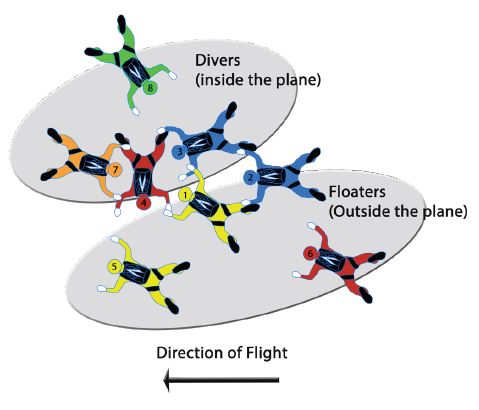USPA is celebrating the 100th anniversary of freefall on April 28 and is encouraging skydivers to submit photos of themselves making 100-shaped formations in the sky, so it’s the perfect time to learn how to make one. The skill may also be handy in the future for celebrating someone’s 100th skydive. The dive plan described here requires eight skydivers plus a videographer. The majority of participants should have prior experience making jumps of this size, and it’s even better if there’s at least one skydiver who has experience organizing jumps of this size.
To build the formation, a group could perform a standard 8-way exit as competition teams do and move directly to building a “1” a “0” and another “0.” Although seemingly the most straightforward way of doing it, it’s actually deceptively difficult. Even very skilled teams may need to make tens of jumps—or more—to execute an 8-way exit successfully. And making three separate, unlinked formations in the sky after the exit is itself a very difficult task.
To increase the probability of success, try a simpler exit with some linked and some unlinked skydivers, followed by a preliminary formation that gathers everyone together so they can make an easy transition to the final formation: the one for the photos.
 THE EXIT
THE EXIT
The exit image depicts the lineup in the door. It consists of a standard 4-way bow exit (jumpers 1, 2, 3 and 4) and one super-point (jumper 7) holding on to jumper 4, making a 5-way linked exit. Jumper 8 is diving unlinked from inside, just behind jumpers 4 and 3. Jumper 5 is a front floater, standing outside in front of jumper 1 and as far forward as possible with chest and right foot pressing up against the front edge of the door, left foot trailing, right hand on the bar and left hand outside of the plane gripping whatever handle is available. Jumper 6 is standing outside just behind jumper 2 with the right foot in the door, left foot trailing, right hand on the bar or outside rail and hanging low. If there is room on the camera step for more than one jumper, jumper 6 can share the step with the videographer to leave more space in the door.
Jumper 1 gives the count. Jumpers 5 and 6 leave a hair early—on “set” of “ready, set, go”—and immediately start tracking up toward the formation. Jumper 7 holds on and goes with the group, diving aggressively so as not to be left behind and arching hard with chin up. It’s easy for jumper 7 to get whipped over the top of the formation if the jumpers are late out the door or don’t arch enough. If so, they can just let go and regroup in the sky. Jumper 8 exits immediately after the group, leaving no time after the 5-way’s exit.
Jumper 1 should be the most experienced skydiver. This jumper will be the base and provide a reference point for everyone else. The next most experienced skydiver should be jumper 2, who is responsible for the last “0.” Jumper 6 also has a challenging setup and should be relatively experienced. Jumpers 7 and 4 can be the least experienced skydivers, because they exit as part of the base and their referencing is more straightforward.
THE PRELIMINARY FORMATION
The goal of the preliminary formation is to gather everyone after the exit and build a relatively easy formation that can transition quickly to get to the final 100-shaped formation. Here’s how to build the preliminary formation from the exit frame in three steps:
Step 1
Once the 5-way bow is ready, jumpers 3 and 1 switch to the donut depicted. Jumpers 5, 6 and 8 just wait their turn without docking.
Step 2
Jumper 2 redocks as depicted. Jumpers 5, 6 and 8 continue waiting their turn without docking.
Step 3
Jumpers 5, 6 and 8 dock in the slots depicted below to form the preliminary formation:
THE FINAL FORMATION
Once the group successfully builds the preliminary formation, the hard work is over, but there’s one more step to do. Jumper 1 signals to move forward to the final formation by letting go of jumper 2. At that point, jumper 2 also releases the grip on jumper 3, while the entire right donut (the second “0,” which consists of jumpers 2, 6 and 5) works hard to stay close and in position relative to the center donut. At the same time, jumpers 8 and 7 let go of jumper 4 and build a 2-way pin, also working hard to continue referencing the middle donut. It’s very easy for the three groups to begin to travel away from each other or turn off heading, so they should constantly work to keep close and in correct position. While everyone is responsible for keeping the groups close, jumper 2 and jumper 8 should take the leadership roles for their subgroups and never take their eyes off the center donut.
And there you have it! Follow these steps and you’ll have a clear, well-defined process that sets everyone up for success. Now go out there, get your “100” and show USPA what you’ve got!
 About the Author
About the Author
Steve Lefkowitz, D-30172, is a founding member of one of the world’s top competition 4-way formation skydiving teams, SDC Rhythm XP. The team coaches skydivers of all levels at Skydive Chicago in Ottawa, Illinois, and Skydive Sebastian in Florida and runs tunnel workshops at the Paraclete XP wind tunnel in North Carolina. The team also created the Rhythm Skydiving 101 and 401 apps and founded the Women’s Skydiving Leadership Network. More information is available at rhythmskydiving.com.